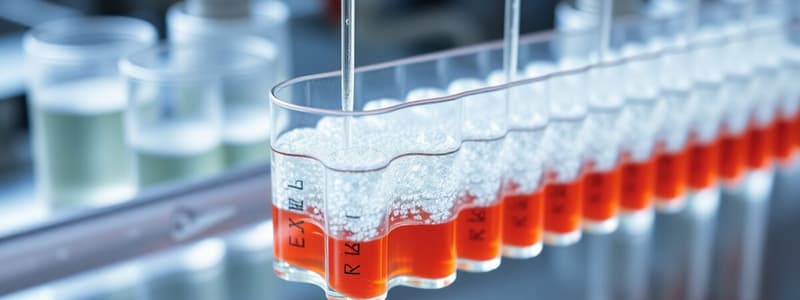Podcast
Questions and Answers
What is the primary focus of membrane separation in chemical engineering?
What is the primary focus of membrane separation in chemical engineering?
- Chemical reaction optimization
- Fluid dynamics analysis
- Heat transfer processes
- Mass transfer processes (correct)
In which department was the content on membrane separation prepared?
In which department was the content on membrane separation prepared?
- Department of Physics
- Department of Chemical Engineering (correct)
- Department of Environmental Science
- Department of Mechanical Engineering
Which university is associated with the membrane separation content?
Which university is associated with the membrane separation content?
- Ain Shams University
- Alexandria University
- Cairo University (correct)
- University of Cairo
Who prepared the content on membrane separation?
Who prepared the content on membrane separation?
What is likely the purpose of the membrane separation processes within chemical engineering?
What is likely the purpose of the membrane separation processes within chemical engineering?
What is the title of the referenced work by Seader, Henley, and Roper?
What is the title of the referenced work by Seader, Henley, and Roper?
In which edition is the work by Seader, Henley, and Roper published?
In which edition is the work by Seader, Henley, and Roper published?
What year was the referenced work by Seader, Henley, and Roper published?
What year was the referenced work by Seader, Henley, and Roper published?
Which publisher is associated with the referenced work by Seader, Henley, and Roper?
Which publisher is associated with the referenced work by Seader, Henley, and Roper?
Who are the authors of the work titled 'Separation Process Principles'?
Who are the authors of the work titled 'Separation Process Principles'?
What type of film is most commonly used in membrane separation for gases and liquids?
What type of film is most commonly used in membrane separation for gases and liquids?
Which of the following materials is NOT typically used as a barrier in membrane separation?
Which of the following materials is NOT typically used as a barrier in membrane separation?
In membrane separation, what is the primary purpose of the barrier?
In membrane separation, what is the primary purpose of the barrier?
Which of the following could be an alternative to a polymeric film in membrane separation?
Which of the following could be an alternative to a polymeric film in membrane separation?
What characteristic does a nonporous membrane possess?
What characteristic does a nonporous membrane possess?
What is the primary function of a membrane in the membrane separation process?
What is the primary function of a membrane in the membrane separation process?
In membrane separation, which statement about the feed components is true?
In membrane separation, which statement about the feed components is true?
Which characteristic defines a semipermeable membrane in the context of membrane separation?
Which characteristic defines a semipermeable membrane in the context of membrane separation?
What does a semipermeable barrier help achieve in the membrane separation process?
What does a semipermeable barrier help achieve in the membrane separation process?
Why might a semipermeable membrane be preferred for separating components in a process?
Why might a semipermeable membrane be preferred for separating components in a process?
What is the standard unit for permeability in the given formula?
What is the standard unit for permeability in the given formula?
How can permeability be converted to SI units based on the formula provided?
How can permeability be converted to SI units based on the formula provided?
What does '𝑃' represent in the context of the formula?
What does '𝑃' represent in the context of the formula?
Which of the following is true about the unit conversion from barrer to SI units?
Which of the following is true about the unit conversion from barrer to SI units?
In the formula presented, how many dimensions does permeability have?
In the formula presented, how many dimensions does permeability have?
What is the thickness of the silica-glass membrane mentioned?
What is the thickness of the silica-glass membrane mentioned?
Which material is specifically mentioned for the membrane?
Which material is specifically mentioned for the membrane?
What characteristic of the membrane is implied with the term 'pores'?
What characteristic of the membrane is implied with the term 'pores'?
Why might the thickness of the membrane be significant?
Why might the thickness of the membrane be significant?
What is most likely a function of the pores in the silica-glass membrane?
What is most likely a function of the pores in the silica-glass membrane?
Flashcards
Mass Transfer
Mass Transfer
The movement of mass from one location to another.
Separation Processes
Separation Processes
Methods for isolating desired components from mixtures.
Membrane Separation
Membrane Separation
Separation technique using a membrane to separate components.
Chemical Engineering
Chemical Engineering
Branch of engineering dealing with chemical reactions & processes.
Signup and view all the flashcards
Faculty of Engineering
Faculty of Engineering
A department within a university dedicated to engineering studies.
Signup and view all the flashcards
Cairo University
Cairo University
A prominent public university in Cairo, Egypt.
Signup and view all the flashcards
Membrane Separation
Membrane Separation
A process where a mixture of components is partially separated using a semipermeable membrane, enabling some species to move faster through it than others.
Signup and view all the flashcards
Feed Mixture
Feed Mixture
A mixture of multiple components intended to be separated.
Signup and view all the flashcards
Semipermeable Membrane
Semipermeable Membrane
A barrier that allows some components to pass through more easily than others.
Signup and view all the flashcards
Membrane separation
Membrane separation
A method to separate gases and liquids using a thin, nonporous, or porous material.
Signup and view all the flashcards
Membrane material
Membrane material
Typically a thin, nonporous polymer film, but can also be porous polymers, ceramics, or metals.
Signup and view all the flashcards
Separation materials
Separation materials
The substances used to separate components like gases and liquids in a mixture.
Signup and view all the flashcards
Separation Process Principles
Separation Process Principles
A book about separation processes in chemical engineering.
Signup and view all the flashcards
Seader, J.D., Henley, E.J.& Roper, K.
Seader, J.D., Henley, E.J.& Roper, K.
Authors of the book "Separation Process Principles".
Signup and view all the flashcards
3rd edition
3rd edition
Specific edition of "Separation Process Principles"
Signup and view all the flashcards
Wiley
Wiley
Publishing company that published "Separation Process Principles"
Signup and view all the flashcards
Chapter 14
Chapter 14
Specific chapter in "Separation Process Principles" book.
Signup and view all the flashcards
Baker, R.
Baker, R.
Another possible reference in literature
Signup and view all the flashcards
Reference List
Reference List
A list of sources used in a document.
Signup and view all the flashcards
Silica-glass membrane
Silica-glass membrane
A thin membrane made of silica glass, often with pores.
Signup and view all the flashcards
2 μm thick
2 μm thick
Describes the thickness of the membrane, which is very thin.
Signup and view all the flashcards
membrane pores
membrane pores
Small openings in the membrane.
Signup and view all the flashcards
Barrer's constant
Barrer's constant
A constant used in calculating permeability, relating to gas transport through a material.
Signup and view all the flashcards
Permeability
Permeability
A measure of a material's ability to allow a gas to pass through it.
Signup and view all the flashcards
Units of Permeability
Units of Permeability
cm^3·cm/cm^2·s·cm Hg; (kmol/m^2/s/Pa)
Signup and view all the flashcards
Conversion factor
Conversion factor
3.348 × 10^-3
Signup and view all the flashcardsStudy Notes
Mass Transfer & Separation Processes: Membrane Separation
- Membrane separation is a process where a feed mixture is partially separated using a semipermeable membrane. Some substances pass through faster than others.
- Membrane separation is used for gases and liquids.
- The membrane barrier is commonly a thin, non-porous polymer film, but can also be porous polymer, ceramic or metal.
- The barrier must not dissolve, disintegrate or break down to maintain selectivity.
Introduction
- Membrane separation is a process where a feed mixture is partially separated using a semipermeable membrane. Certain components pass through the membrane faster than others.
Basic Concepts and Terminologies
- Retentate (reject): The part of the feed that does not pass through the membrane.
- Permeate: The substance that does pass through the membrane.
- Sweep: A liquid or gas used to facilitate permeate removal.
- Permeance of a membrane: The membrane must have high permeance and a high permeance ratio, or selectivity, for the two materials being separated. This is analogous to a mass-transfer coefficient.
Types of Membranes
- Isotropic microporous: Rigid structure with randomly-distributed, small pores (0.01-10 µm diameter). Separation based on molecule size.
- Symmetrical nonporous dense: Consist of a dense film. Molecules are transported by diffusion based on pressure, concentration, or electrical potential. Separation is based on the molecules' diffusive and solubility rate.
- Electrically charged: Dense or microporous with pore walls containing fixed charged ions (positive or negative). Separation is based on exclusion of ions with the similar charge of the fixed ions.
- Anisotropic: Consists of an extremely thin surface layer on a much thicker, porous substructure. The layers may be made of different polymers, and higher fluxes are seen.
- Ceramic and metal: A special class of microporous membranes, these are used for ultrafiltration and microfiltration applications where solvent resistance and thermal stability are required. Dense metal membranes, such as palladium membranes, are used in hydrogen separation.
Membrane Shapes
- Flat sheets: 1m x 1m x 200µm, up to 0.5 µm skin
- Tubular: 0.5-5 cm diameter, up to 6m long.
- Hollow fibers: ID 48µm, OD 85µm x 1.2m long, provides larger area per unit volume.
- Honeycomb/Monolithic: Flow channels (0.3-0.6 cm diameter) in a porous support material.
Membrane Modules
- Plate and frame: Flat sheets separated by support plates.
- Spiral wound: Laminate composed of two membrane sheets separated by spacers, wound around a central tube.
- Hollow fiber: Resembles a shell-and-tube heat exchanger.
- Tubular: Similar to a heat exchanger, feed flows through tubes.
Membrane Module Characteristics
- Packing density: Membrane surface area per unit volume of module.
- Resistance to fouling: Resistance of the module to fouling.
- Ease of cleaning: Ease of cleaning the module.
- Relative cost: Cost of the module.
- Applications: Typical applications for each style of membrane module.
Studying That Suits You
Use AI to generate personalized quizzes and flashcards to suit your learning preferences.



